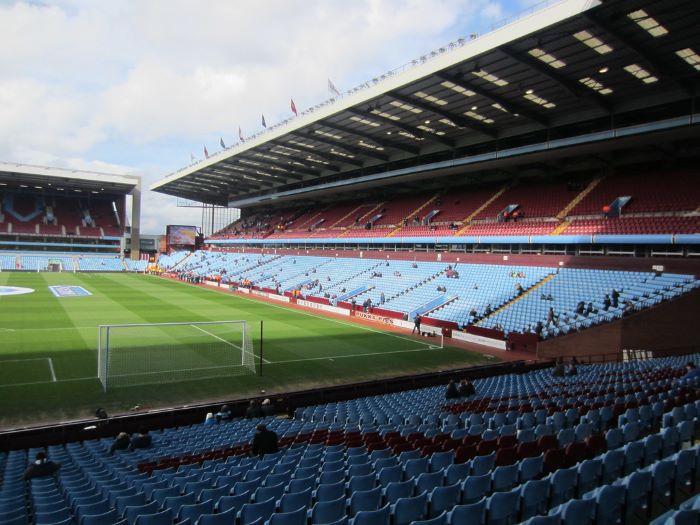Table of Contents
ToggleThe Premier League Aston Villa Stadium, Villa Park
Name: Villa Park
Location: Trinity Road, Birmingham
Owner: Aston Villa FC
Capacity: 42,657
Record attendance: 76,588 (Aston Villa vs Derby County, 2 March 1946)
Opened: 1897
Construction cost: £16,733 (£25 mil)
Aston Villa Stadium, better known as Villa Park, is an iconic football stadium situated in the heart of Aston, Birmingham. This legendary stadium has been the home ground of the Premier League giants Aston Villa since its foundation in 1897.
With a seating capacity of 42,657, it has hosted lots of football triumphs and memorable moments. Villa Park’s rich history extends beyond football, having hosted a diverse range of events, from international rugby matches to concerts.
History of Villa Park
In 1897, Aston Villa made a monumental move to Villa Park from their former venue, Wellington Road, which had become plagued by numerous issues. The team sought a new home that could accommodate their growing fanbase and offer improved facilities.
Situated on the grounds of the historical Jacobean stately home, Villa Park’s development was set in motion.
Much of the credit for Villa Park’s design goes to Frederick Rinder, Villa’s Chairman and a trained surveyor. He meticulously laid down every level and line of the ground himself. The stadium was envisioned with a new cement cycle track, main stand on the Witton Lane side, and banking that enclosed both the track and pitch.
After some delays, Villa Park opened its doors to the public on April 17, 1897, hosting a friendly match against Blackburn Rovers.
Villa Park Expansion
Villa’s success on the field led to an increase in attendance, prompting the need for ground improvements. The first phase extended the terrace on the Trinity Road side, followed by a second phase to rectify sightline issues caused by a design flaw.
In 1911, Villa purchased the freehold of the ground, setting the stage for ambitious expansion plans that would have taken Villa Park’s capacity to 104,000. However, the outbreak of World War I hampered these efforts.
In the early 1920s, Villa Park underwent significant enhancements, inspired by the work of renowned architect Archibald Leitch. The cycling track was removed, the terracing was reprofiled, and banked end stands were introduced at the Holte and Witton ends. The original Victorian Lower Grounds buildings, including the aquarium and bowling greens, were also incorporated into the design.
The Trinity Road Stand, featuring stained glass windows, Italian mosaics, and a sweeping staircase, was officially opened in January 1924. Considered Leitch’s masterpiece, it was dubbed the “St Pancras of football.”
Villa Park Post-War Development and Modernization
Post-World War II, Villa Park saw several projects to modernize and expand the stadium. New floodlight pylons were installed, a roof was added to the Holte End, and seating gradually replaced terracing to comply with safety standards. The Witton Lane Stand was renamed the North Stand, and the Doug Ellis Stand was introduced, further enhancing the stadium’s facilities.
The 1980s and 1990s brought significant changes to Villa Park. In response to the Hillsborough disaster, Villa Park began transitioning to an all-seater stadium. The Holte End, the last remaining stand without seating, underwent a complete overhaul, resulting in a two-tiered structure. This redevelopment was followed by the demolition and reconstruction of the Trinity Road Stand in 2000, further increasing the stadium’s capacity.
Villa Park Structure and Facilities
Today, one of the most popular Premier League football clubs in the world, Villa Park has a capacity of 42,682 seats, divided among four stands: the Holte End, Trinity Road Stand, Doug Ellis Stand, and North Stand. The Holte End, the most renowned among supporters, is a large two-tiered stand with an iconic facade.
The Trinity Road Stand is the newest, featuring three tiers and housing dressing rooms and director’s boxes. The North Stand, built in 1977, has two tiers and executive boxes. The Doug Ellis Stand is another two-tiered stand and features the main television camera viewpoint.
Under the ownership of Nassef Sawiris and Wes Edens, the club has a long-term redevelopment plan.
The North Stand is set for a complete rebuild, accompanied by developments to the Trinity Road Stand. These changes will increase Villa Park’s capacity to approximately 50,065 and introduce a new commercial and entertainment venue called “Villa Live.” Further plans may see the Doug Ellis Stand and the Holte End reconfigured, potentially boosting capacity to 52,000 to 53,000.
Conclusion
Villa Park, the historic home of Aston Villa Football Club, stands as a testament to the enduring passion of football fans and the ever-evolving landscape of sports stadiums. From its humble beginnings as Aston Lower Grounds to its ambitious redevelopment plans, Villa Park has consistently adapted to meet the demands of modern sport. With its rich history, iconic stands, and exciting future projects, Villa Park remains a cherished jewel in the crown of English football stadiums.


